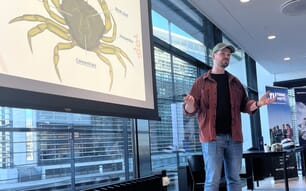Arild Giske, who owns a fish processing business in Ålesund and has long been looking for a use of the backs of saithe, has come up with an idea to use them to fill ready-made bait bags.
“When we make clipfish [traditional dried fish] out of cod, we have no problem selling the fish backs, which are exported to Asia, primarily China and Vietnam. By contrast, no-one wants to buy saithe backs, and in the worst case scenario, this could become a major waste problem,” he says.
He had been contemplating how to turn the problem into an opportunity for a profitable sideline for many years, but things really started taking off when he and his colleagues developed a special piece of equipment to create bait bags.

© Rune Stoltz Bertinussen © Nofima
“I’m not entirely unfamiliar with crab fishing, having done it myself in Alaska more than 30 years ago. I remember that handling the bait was time-consuming and difficult and have always thought there must be a better way of baiting the pots,” he says.
Scientific approval
The crab feed idea was presented to Sten Ivar Siikavuopio, a senior scientist at Nofima in Tromsø who has been researching both various types of bait for king crab since 1994. He had already concluded that saithe is by far the best bait to catch crab.
“When I saw the prototype, I was instantly taken with it, in part because the stocking is made of cotton, not nylon. In this way, we can avoid commercial snow crab fishing adding to the global problem of plastic pollution in the sea,” he explains.
After a year of research and systematic testing, the first full-scale trial catch is being done this December. Nofima’s tests have already concluded that the saithe-back crab bait is better, cheaper and easier to use than the current alternatives.
Better, cheaper, and easier
A stocking containing chopped up saithe backs can stay in the crab pots for up to a week. Bait made of herring, which is one of the alternatives, cannot withstand the pressure at depths of 200 metres. This means that the pots must be turned more often, pushing production costs up for the fishermen.
Squid is currently the most commonly used crab bait. It is caught in the Southern Ocean and imported from Argentina, and can cost as much as NOK 23 a kilo. Preliminary estimates show that the bait made from saithe backs will cost less than half.
Today bait is bought in frozen blocks that are cut up and put in the pots while the vessels are out at sea. With up to 9,000 pots on each vessel and with temperatures down to -20 C, it goes without saying that this work requires a significant crew. Saithe back bait comes pre-packaged in one and a half kilo units, adapted to the size of the pots, making it much easier to handle out at sea.
“What we need to find out now is the best way of preserving the bait. Until now, we have been freezing it, but if salting works just as well, this would make it much cheaper to produce, allowing us to further reduce the retail price,” Giske explains.
Vast potential
This new invention has enormous potential: at present each boat takes 40 tonnes of bait out on every voyage up to the Barents Sea in search of snow crab. The catch quota in the Norwegian zone is currently 4,000 tonnes of crab, while in the Russian zone up to 10,000 tonnes can be caught. But these numbers are expected to explode over the course of the next few years.
“Snow crab was not discovered until 1996 and is the fastest growing species in the Barents Sea. In contrast to the more famous king crab, snow crab will stay in the Barents Sea. While king crab tend to migrate towards the coast, snow crab thrive out in deep waters and love the cold,” says Siikavuopio.
“In the long term, the stock will become so strong that it will be possible to catch between 50,000 and 100,000 tonnes a year, and with time we expect the quota in the Norwegian zone to increase relative to the Russian quota. Regardless, it is safe to say that catching snow crab will become the second most important fishery in the Barents Sea after cod. How profitable it will be is directly related to efficiency and the cost of bait, which are currently the main cost factors for the fishermen,” says Siikavuopio.




